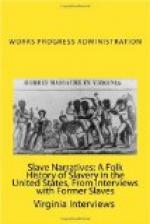Yes, madam, I do remember that the emancipated slaves were led to believe they would be given property and have just what their masters had been accustomed to enjoy. I remember hearing my mother tell, in later years, that she really had expected to live as her mistress had; having some one to wait upon her, plenty of money to spend, ride in a carriage with a coachman. But she always added that the emancipated ones soon found out that freedom meant more work and harder than they had ever done before.
What did they work at? Pardon me please for so often reminding you of conditions of that time. Few of the trades workers were white. Brick makers and brick layers, stone masons, lathers, plasters,—all types of builders were of the freed men. You must remember that slaves were the only ones who did this work. Their masters had used their labor as their means of income. Not all slaves were in the cotton fields, as some suppose. The slave owners of towns and villages had their slaves learn skilled trade occupations and made a great deal of money by their earnings. The Yankee soldiers and the many Northern people who lived here hired the freed men and paid them. Quite soon the colored people were buying homes. Many were even hired by their former masters and paid for the work they formerly did without pay under slavery.
I remember Bill Read and Dave Lowe. They had been coachmen before freedom. By combining their first savings, they bought a hack, as it was called. It was more of a cab. For all those who did not have private conveyances, this was the only way of getting about town. It was Little Rock’s first taxi-cab business, I should say. Bill and Dave made a fortune; they had a monopoly of business for years and eventually had enough cabs to take the entire population to big evening parties, theater, and all places where crowds would gather.
No, madam, I do not recall that we had any inconvenience from the Ku Klux Klan. If they made trouble in Little Rock I do not now remember it. I did hear that out in the country they drove people from their homes. Yes, madam, I do remember, quite distinctly, the times when colored men were voted into public offices. John C. Corbin was State Superintendent of Public Instruction. Phillips county sent two colored men to the legislature; they were W.H. Gray and H.H. White, both from Helena. J.E. Bush of this city followed M.W. Gibbs as Police Judge. After reconstruction when all colored people were eliminated from public life all these people returned to their trade.
I was 22 when I married. My husband was a teacher but knew the carpenter trade. During the time that Negroes served in public office he served as deputy sheriff and deputy constable. He was with me for 41 years before his death; we raised a family of six children and gave each one a college education.




